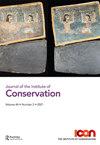采用方法学方法确定历史照片中使用的主要成分
IF 0.5
0 HUMANITIES, MULTIDISCIPLINARY
引用次数: 1
摘要
摘要在这项工作中,提出了一种使用非侵入性和非破坏性表征技术来识别历史照片中使用的成分的方法。该方法提供了一种通过流程图中所示的以下三个步骤来分析照片的方法:首先,通过识别形态和结构特征来确定粘合剂的类型;其次,确定了baryta层的存在与否;并且最后确定用作保护层的一部分的有机组分的存在。使用这种方法揭示的特征和性质通过不同的分析技术确定了历史照片的类型,这些技术为首次进行的任何定性观测提供了基于科学的证据。这些技术是可互换的,因为它们通过使用红外光谱、拉曼光谱、红外光谱椭圆偏振法、共焦显微镜和原子力显微镜等来识别照片中的特定特征。因此,所提出的方法有助于对照片进行安全的循证分类,并为照片的保护提供有价值的信息。本文章由计算机程序翻译,如有差异,请以英文原文为准。
Towards a methodological approach to identify the main components used in historic photographs
Abstract In this work, a methodology is proposed to identify the components used in historic photographs using non-invasive and non-destructive characterisation techniques. The methodology provides an approach for analysing photographs by following three steps represented in a flowchart: firstly, the type of binder is determined by identifying morphological and structural characteristics; secondly, the presence or absence of a baryta layer is established; and finally, the presence of organic components used as part of a protective layer is determined. The characteristics and properties revealed using this methodology identify the type of historic photograph through different analytical techniques that provide science-based evidence for any qualitative observations first made. These techniques are interchangeable as they identify specific characteristics in the photographs by using infrared spectroscopy, Raman spectroscopy, infrared spectroscopic ellipsometry, confocal microscopy and atomic force microscopy, among others. As such, the methodology proposed facilitates a secure evidence-based classification of photographs and provides valuable information for their conservation.
求助全文
通过发布文献求助,成功后即可免费获取论文全文。
去求助
来源期刊

Journal of the Institute of Conservation
HUMANITIES, MULTIDISCIPLINARY-
CiteScore
1.50
自引率
0.00%
发文量
22
期刊介绍:
The Journal of the Institute of Conservation is the peer reviewed publication of the Institute of Conservation (Icon). As such, its aims reflect those of Icon, to advance knowledge and education in conservation and achieve the long term preservation and conservation of moveable and immoveable cultural heritage. The Journal provides a collective identity for conservators; it promotes and supports both the profession and professionalism. With international contributions on all aspects of conservation, it is an invaluable resource for the heritage sector. The specific aims of the Journal are to: 1. promote research, knowledge and understanding of cultural heritage conservation through its history, practice and theory 2. provide an international forum to enable and disseminate advances in research, knowledge and understanding relating to conservation and heritage 3. champion and support professional standards of heritage conservation in the UK and internationally 4. provide a permanent record of issues relating to conservation and heritage 5. be financially and operationally sustainable. To achieve these aims, the Journal invites contributions from all those involved in the conservation of cultural heritage and related activities. Areas of interest include understanding cultural heritage materials and their degradation; subject reviews and histories of cultural heritage materials and conservation treatments; new, innovative or improved approaches to conservation and collections care theory, practice, communication, management and training; case studies demonstrating new, innovative or improved approaches; and conservation in its wider context. Submitters are encouraged to demonstrate how their work is of practical application to conservation. To maintain professional standards and promote academic rigour, submissions of articles and shorter notices are subject to an anonymous peer review process.
 求助内容:
求助内容: 应助结果提醒方式:
应助结果提醒方式:


